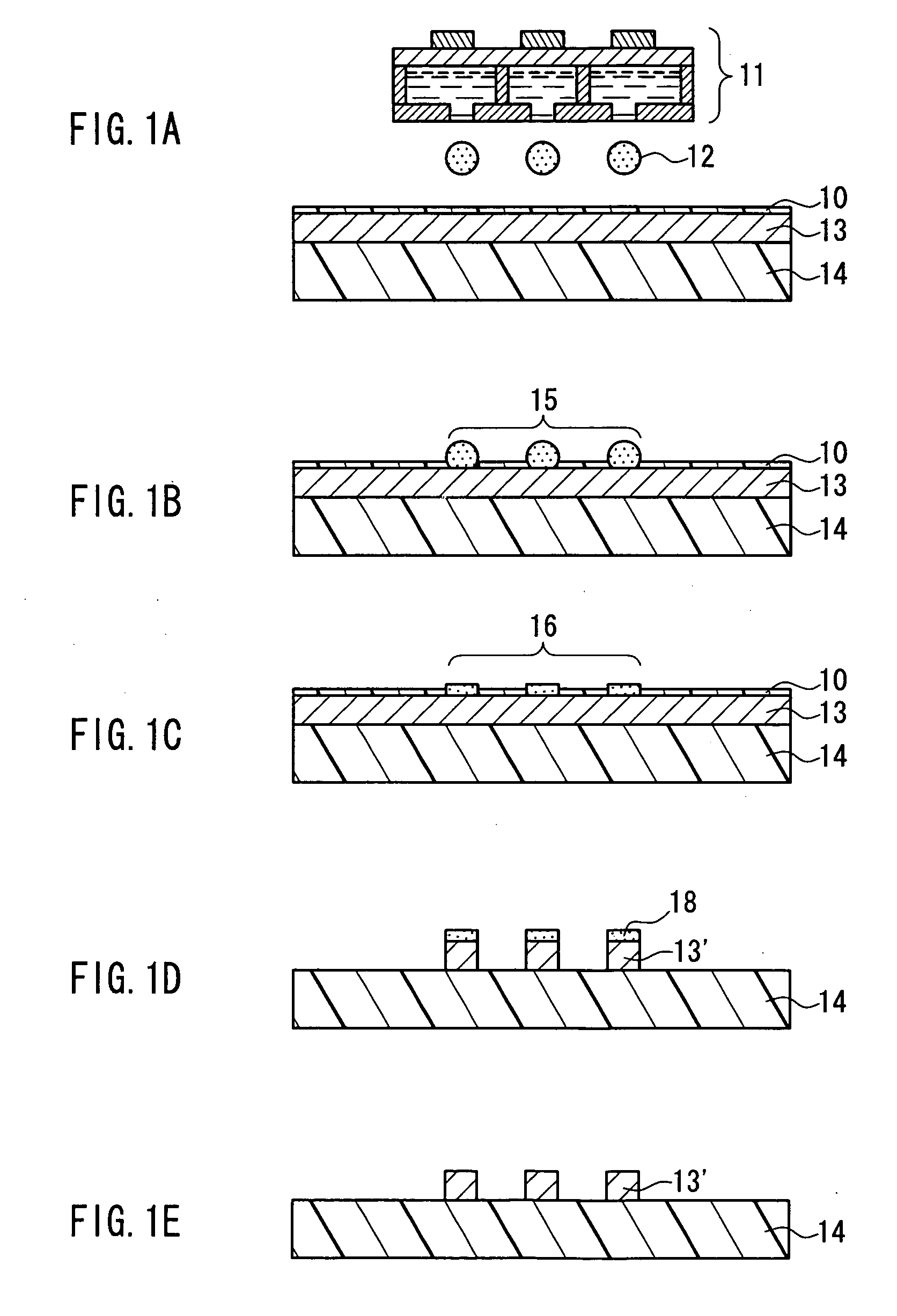Metal pattern and process for producing the same
a technology of metal patterns and metal parts, applied in the field of metal patterns, can solve the problems of increasing manufacturing costs, waste of materials, and waste of 90% or more of resist solutions in the resist application process, and achieve the effects of reducing manufacturing costs, reducing manufacturing costs, and increasing manufacturing costs
- Summary
- Abstract
- Description
- Claims
- Application Information
AI Technical Summary
Benefits of technology
Problems solved by technology
Method used
Image
Examples
example 1
(1) Preparation of Substrate
[0093]A surface of a 4-inch silicon wafer was exposed to an ozone atmosphere at 110° C. so that organic matters on the surface were removed, and subsequently a 300 nm-thick copper film was formed on the surface by electron-beam evaporation.
(2) Formation of A Monomolecular Film Having Fluorinated Alkyl Chains
[0094]An ethanol solution in which CF3(CF2)7C2H4SH was dissolved at a concentration of 10−4 vol % was prepared. The silicon wafer with the copper film formed thereon was immersed in the foregoing solution for a predetermined time, and was removed therefrom. The silicon wafer then was washed with pure ethanol, and subsequently was washed with running pure water. The water repellency of a monomolecular film thus formed was evaluated by measuring a static contact angle of the film with respect to pure water.
(3) Preparation of Liquid To Be Jetted
[0095]An ethanol solution in which hexadecane thiol (CH3(CH2)15SH) was dissolved at a concentration of 0.1 vol %...
example 2
[0114]Copper patterning was carried out in the same manner as that of Example 1 except that each monomolecular film having fluorinated alkyl chains was formed by the following method.
(1) Formation of Monomolecular Film Having Fluorinated Alkyl Chains
[0115]After a silicon wafer was immersed for a predetermined time in a solution of a mixture of n-hexadecane and chloroform (volume ratio: 4:1) in which CF3(CF2)7C2H4SiCl3 was dissolved at a concentration of 10−4 vol %, the silicon wafer was washed with chloroform. The foregoing process was carried out in a glove box filled with dried nitrogen. Next, the silicon wafer was removed from the glove box, and was washed with running water for approximately 5 minutes.
(2) Result
[0116]The result is shown in Table 2 below. With immersion for 1 to 20 minutes, copper patterns were formed in the same manner as Example 1.
[0117]As a result of the immersion for 60 minutes, a maximum line width of 102 μm was obtained, which was close to a value of the id...
example 3
[0123]Copper patterning was carried out in the same manner as that of Example 1 except that each monomolecular film having fluorinated alkyl chains was formed by the following method.
(1) Formation of Monomolecular Film Having Fluorinated Alkyl Chains
[0124]After a silicon wafer was immersed for a predetermined time in an ethanol solution in which 0.1 vol % of CF3(CF2)7C2H4Si(OCH3)3, 1 vol % of water, and 0.01 vol % of hydrochloric acid were dissolved, the silicon wafer was washed with ethanol. Thereafter, the silicon wafer was washed with running pure water.
(2) Result
[0125]The result is shown in Table 3 below. With immersion for 30 to 120 minutes, copper patterns were formed in the same manner as Example 1.
[0126]As a result of the immersion for 240 minutes, a maximum line width of 102 μm was obtained, which was close to a value of the ideal pattern, but copper remained partially in a region onto which the solution was not jetted, not being removed by etching. It is supposed that this...
PUM
| Property | Measurement | Unit |
|---|---|---|
| temperature | aaaaa | aaaaa |
| particle diameter | aaaaa | aaaaa |
| particle diameter | aaaaa | aaaaa |
Abstract
Description
Claims
Application Information
 Login to View More
Login to View More - R&D
- Intellectual Property
- Life Sciences
- Materials
- Tech Scout
- Unparalleled Data Quality
- Higher Quality Content
- 60% Fewer Hallucinations
Browse by: Latest US Patents, China's latest patents, Technical Efficacy Thesaurus, Application Domain, Technology Topic, Popular Technical Reports.
© 2025 PatSnap. All rights reserved.Legal|Privacy policy|Modern Slavery Act Transparency Statement|Sitemap|About US| Contact US: help@patsnap.com



